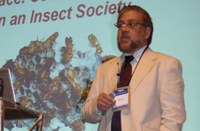 Trained as a molecular biologist, Gadagkar (TWAS Fellow 2000) has been carefully watching the behaviour of wasps for more than 40 years. What began as a hobby in the 1970s eventually turned into a profession. Today, he is one the world's foremost "waspologists". Gadagkar spoke passionately about his research at the TWAS 21st General Assembly in Hyderabad.
Trained as a molecular biologist, Gadagkar (TWAS Fellow 2000) has been carefully watching the behaviour of wasps for more than 40 years. What began as a hobby in the 1970s eventually turned into a profession. Today, he is one the world's foremost "waspologists". Gadagkar spoke passionately about his research at the TWAS 21st General Assembly in Hyderabad.
"There are many insects that have sophisticated social arrangements," Gadagkar says. "The best known are honey bees. Residing in colonies with populations of more than 60,000, they live altruistic lives in the service of the queen."
"The social arrangements for wasps are different," he notes. "For example, unlike a queen honey bee, a queen wasp looks no different than her workers and drones. Moreover, unlike queens of other wasp species that will aggressively attack uncooperative members of the colony, the queen wasp in the species that I study, Ropalidia marginata, rarely rules by physical force – except at the beginning of her reign when she asserts her authority to show the others who is in charge. Subsequently, she uses pheromones to dictate behaviour," he says. These are chemical secretions that elicit a desired social response among her subjects.
Gadagkar says that what he does is not that much different than what an anthropologist does. But instead of meticulously studying humans, he studies wasps to uncover patterns of behaviour that shed light on social interactions. He has spent much of his time studying the wasp species Ropalidia marginata, which live in colonies of 40 to 50 members.
"There are thousands of species of wasps," he explains "Some species – solitary wasps – live alone. Others – social wasps – typically live in colonies that can reach populations of up to 100. The advantage of studying theRopalidia marginata species is that it is large enough in size to observe group interaction but small enough to keep a careful watch on individual members."
Gadagkar and his students identify each wasp with "a dot of non-toxic paint" and they sometimes even give their wasps names. They not only intensely observe them in their nests, but also deliberately intervene to try to answer specific questions about their behaviour under specific situations.
For example, they have removed the queen wasp from the colony to see how the rest of the colony reacts. What they have discovered is that one wasp – "the wasp in waiting" – begins to act aggressively to exert her authority. The other members of the colony, meanwhile, continue to function normally and go about their daily chores.
For Gadagkar, this suggests that work within the nest is largely decentralized and self-organizing and that the worker wasps can function (but, of course, not reproduce) without a queen. Within a week, all is back in order, as the new queen wasp assumes the throne. There is no overt struggle for succession.
And what if the old queen wasp returns? The new queen peacefully acknowledges the old queen's rightful place in the colony and returns to her previous social status as a worker bee.
As part of a life-long scientific investigation into the social life of wasps, Gadagkar and his students have done a host of other experiments – for example, they have moved and divided colonies, swapped queen wasps from one nest to another, introduced outside members into the colony and limited a colony's food supply.
It has been a fascinating adventure of discovery that he hopes places a mirror on our own human behaviour and encourages us to reflect on who we are – and how unique and superior we may actually be after all.
Also see T.V. Padma's blog entry about Gadagkar's presentation.

